9-19-14
Rocks in My Pockets: Spirited Away by Signe Baumane
By Diane Sippl
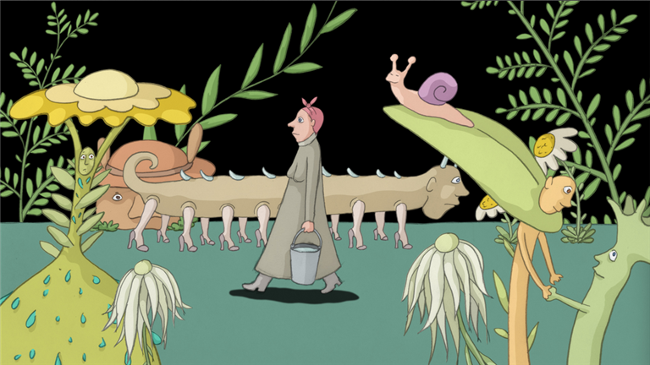
For me, entertainment is getting transported to another reality,
where you learn something new about that world — about life.
Signe Baumane, Rocks in My Pockets
Painting is silent poetry, and poetry is painting that speaks.
Simonides
When New York-based filmmaker Signe Baumane takes us to “another reality,” at least in her latest film, Rocks in My Pockets, it is at once cultural and historical, spanning a hundred years of life in Latvia, the tiny Baltic republic where she was born. That reality is also swimming in politics — internationally so, contending with Russians, Nazis, and Soviets, and also domestically so, under strait-jacketing codes for gender roles. The story depicts five striking and well-educated women in one extended family, including the filmmaker, who have all fought for their lives.
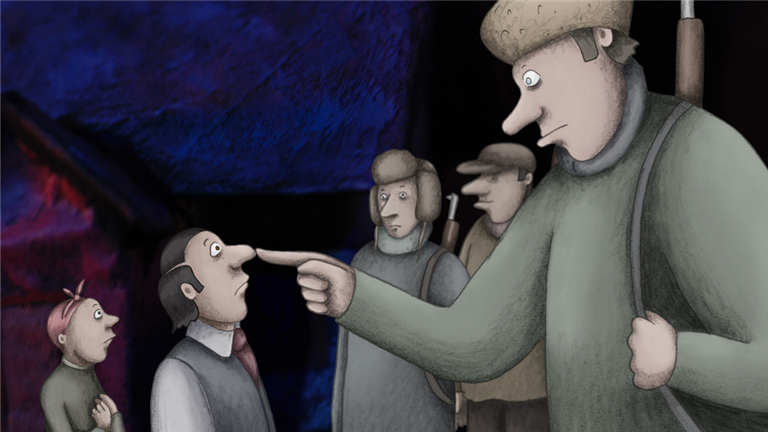
And this is the most surprising of all — the film’s personal politics, the on-going struggle with feelings — with a dark inner world that instills a wish to die. The film opens with such a lyrically expressed take on depression, one so ironically animated, that we feel hand-carried to a curious nether-world where it’s okay to laugh beside injustice and sadness alike. The director’s own lilting voice charms us with its musical intonation and an uncanny, surreal feeling that captivates as it astonishes and informs non-stop for nearly an hour and a half.
To say that Signe Baumane’s debut feature film (that she directed, produced, wrote, drew, sculpted, and narrated) is a courageous effort on every front, autobiographical and ambitious as it is, is true enough and yet hardly attests to the artistry and authorial integrity of one of the boldest works of independent cinema to appear this year. On September 12th Rocks in My Pockets opened in Los Angeles at Laemmle’s Royal Theater to a crowd eager for the lively post-screening Q&A with the filmmaker and her co-producer and partner, theatre director and entrepreneur Sturgis Warner, which was repeated on Saturday and Sunday. What follows are excerpts from the discussions on two evenings following the West Coast premiere of the award-winning animation feature, Rocks in My Pockets.
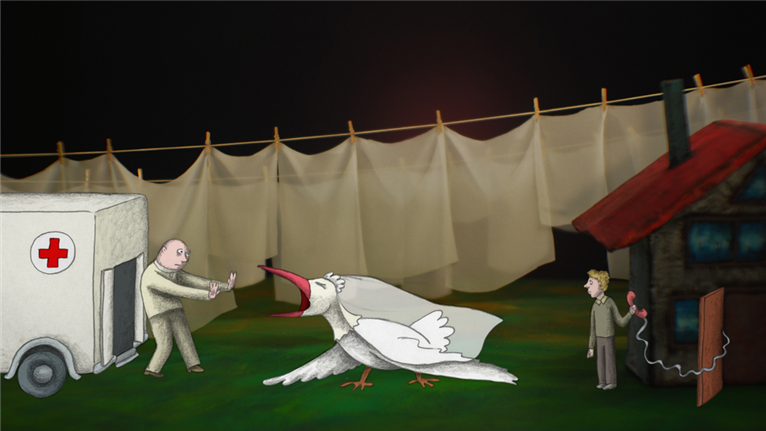
How did taking time to research your personal history change your life?
SB: How did I research it? Bits and pieces always came to me. It’s like a poem. At age eighteen I began to write it down, but then at forty, I looked at my notes and thought, “Eighteen-year-olds are so stupid!” So I took a few photos to be able to remember, and I worked from there. I wanted to write down how depression feels, but from the inside. Sturgis pushed me to write it, and once I did, I knew I couldn’t look at anyone else’s description, because I needed it to be mine. It was the hardest part, and when I read it for the first time to an audience, I broke down. I couldn’t finish, until we went to the recording studio.
Some of my relatives tried to stop me when they found out I was making this film. I didn’t see how they could. In animation filmmaking, you can only create three seconds a day, so you have a lot of thoughts when you zoom in so much. But now I’ve zoomed out — I was alone with it for so long, but now Sturgis’ family likes me more!
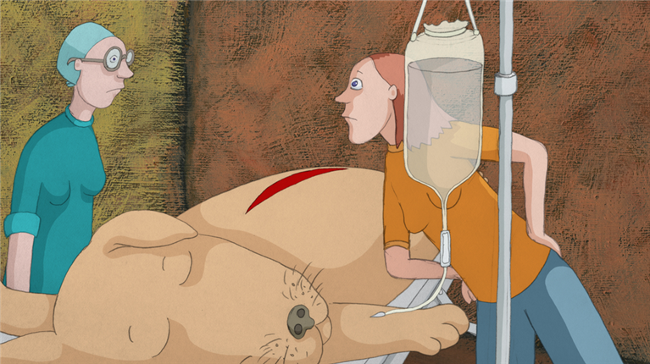
SW: First Signe wrote it, like a one-person play, a monologue. So in 2010, we started with the script. Then we developed the dramaturgy in it. We rehearsed every day for hours, for seven weeks. It was a process. About the fourth or fifth week, the story really started to emerge from her in a visceral sense. We had to keep it dynamic to hold the audience, because it’s her voice non-stop for 88 minutes. It’s imposing theatre on animation film, and no one does it.
Then we did a live reading of it for at least twenty friends. We recorded the entire voice-over in ten hours in a studio — not a long time. We did it twenty minutes at a time. She didn’t memorize it but just felt it flow.
You play multiple characters, but did you ever consider showing your characters speaking?
SB: I’m not an actor. I’m a short filmmaker. There were 34 pages to read — I had a nervous breakdown! Who am I? Meryl Streep? Me, do that — for 90 minutes? But I did…
My film’s content is Eastern
European, and its tone is American. The
intonation and emotion of the voice-over really carry the ebb and flow. I didn’t move the mouths of the characters
because the narration is from my head, and that wouldn’t work. Regarding my accent, I have no intention to
drop it. It’s who I am.
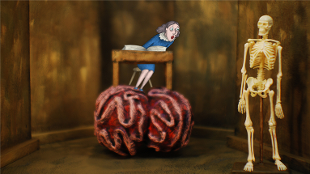
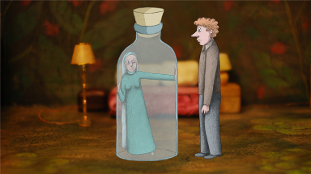
Did you work with a storyboard?
SB: There was never any storyboard. I built the sets of papier-mâché, from the New York Times I gathered on the street and glued together. I didn’t want to show too much, but to move something all the time. The 3-D backgrounds make it easier for the audience to suspend disbelief than when flat images are used.
Stop-motion was new for me, because I do hand-drawn animation. Of course you don’t just move things for stop-motion; you have to light them. Sturgis knew more about lighting from his theatre work, and I got the camera lights. So we took pictures of the 3-D objects and did the layouts.
All was done by hand by me, but in the end, it was digitized and I used interns. I did hand-drawn animation (30,000 drawings and shadings) on top of the layouts, and then my assistants scanned them into the computer and my compositor put it all together. Each shot moves at exactly the same length, so it’s a smooth progression. Then came the sound and the music. We did three test readings with audiences, and in the end, we cut the length of the film from 93 to 88 minutes.
Who are the ghost characters in your film? Are they based on folk tales or myths?
SB: There is a Forest Spirit, who brings growth and life, and a Water Spirit, who brings death. They’re not from any folk lore or mythology; they’re just in my film.
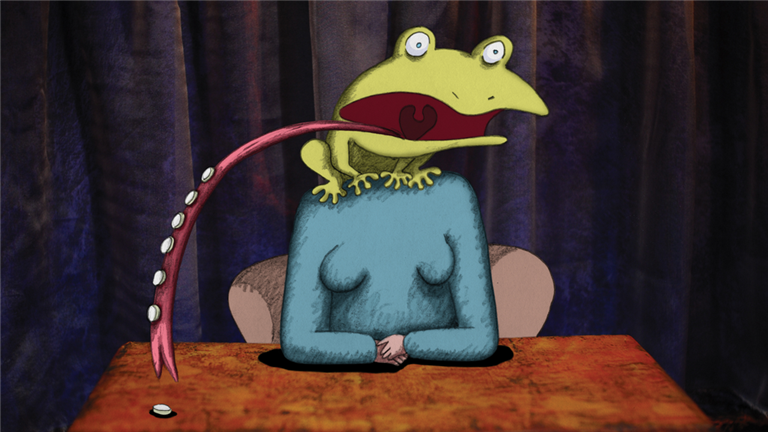
Did you show the film in Latvia? What was the reception?
SB: My whole family and I wanted the voice-over to be in English only (the older people in my family don’t know English), but the kick-starters for the film in Latvia demanded a Latvian version, and I also had a Latvian producer. So on August 23rd at the premiere in Latvia, 6,000 people came, and 60 were my relatives. My dad had invited them. Some walked out, some cried, some worried. In the end, some in my family said, “Signe, you should not have given out family secrets, because who’s gonna marry anyone from our family now?” But it turned out that lots of people in the audience we’re saying, “No — That’s my family, too!” So maybe we’re the same? It’s okay, if we just talk, and deal with it. My mom really fought for this film and said, “If anyone complains, I’m gonna stand between them and your film and fight.”
You can’t flinch — you can’t shiver about it. I want to communicate. I do feel very exposed with this film; but I also feel that having a variety of points of view expressed is really important — not just my view, but independent points of view. I feel I’m opening a dialogue, engaging people in a conversation.
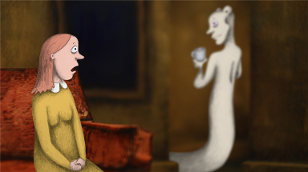
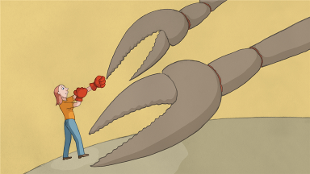
You suggest that depression and mental illness may be genetic, but Latvians have suffered so much in the last century, and suicide rates have been so high there, that maybe there are socio-cultural factors as well.
SB: Yes, but Russia and Finland suffered, too, so Latvians are not the only ones. I didn’t experience any war, so why me? True, there is seasonal depression in countries with long winters.
But there’s no reason for me to be depressed. It comes and goes with no control. It does help to have a project — that alone holds me. What helps is a very structured life — for the day, the week, the year. Structure really holds me up.
I didn’t make this film to heal, as people do after a crisis, a divorce, or a death, to do something therapeutic, because I’m not gonna heal; it’s something inside me. I actually made this film for you guys.
There is no catharsis for me, no matter what I do: this thing is coming back every six months for six weeks and stinging me. But I keep going. I have felt that this film is more important than me, so it gives meaning to my existence. If I have a project I’m better off.
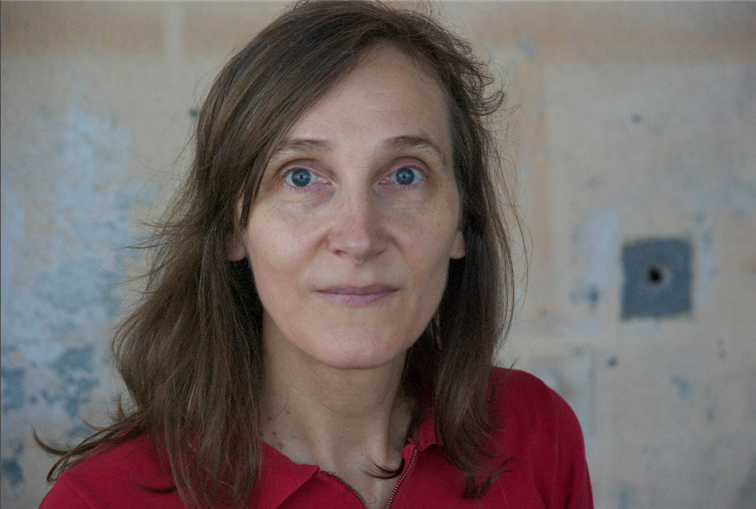
Have you always made animation films? What’s next?
SB: I studied Philosophy for five years at Moscow State University, and the first thing I did was go straight to animation. I’ve made fifteen short films, and they’re all animation.
I have four scripts I want to make into films, a feature about sex and a feature about marriage. Each takes four years. I have my short films with me here, one from 2008, The Teat-Beat of Sex, about sex from a woman’s point of view. This could be developed. The way I present sex is not very sellable compared to porn! Another script I have is about marriage. Society wants us to divide it up into gender roles.
SW: As for Rocks in My Pockets, for those of you who can’t make it to the theater to see it, at the end of this year we’ll stream the film, and you can download it.
Rocks in My Pockets
Director: Signe Baumane; Voice-Over Director: Sturgis Warner; Producers: Signe Baumane, Sturgis Warner; Screenplay: Signe Baumane; Animator: Signe Baumane; Music: Kristian Sensini; Editor/Compositor: Wendy Cong Zhao; Sound: Weston Fonger; Color Design/Production Manager: Rashida Nasir.
Voice-Over: Signe Baumane
Color/Animated; DCP, Blu-ray and HD-CAM; 88 min. In English.